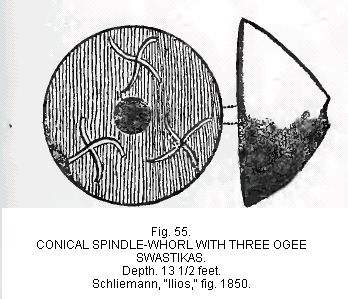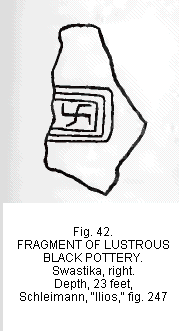

Dispersion of the Swastika
relation to Swastika thus:
Eighty-two representing stars; 70 representing suns; 42 representing branches
of trees or palms; 15 animals non-ferocious, deer, antelope, hare, swan,
ect.; total 209 objects. Many of these were whorls.
Dr Schliemann, in his
works, “Torja” and “Ilios,” describes at length his excavations of these
cities and his discoveries of the Swastika on many objects. His reports
are grouped under titles of the various cities, first, second, third,
etc., up to the seventh city, counting always from the bottom, the first
being deepest and oldest. The same system will be here pursued. The first
and second cities were 45 to 52 feet (13 to 16 meters) deep; the third,
23to 33feet (7 to 10 meters) deep; the fourth city, 13 to 17.6 feet (4
to 5 ½ meters) deep; the fifth city, 7 to 13 feet (2 to 4 meters) deep;
the sixth was the Lydian city of Troy, and the seventh city, the Greek
Ilium, approached the surface.
First and Second Cities,—
But few whorls were found in the first and second cities
(1) and none of these bore the Swastika mark, while
thousands were found in the third, fourth, and fifth cities, many of which
bore the Swastika mark. Those of the first city, if unornamented, have
a uniform lustrous black color and are the shape of a cone  (fig.
55) or of two cones joined at the base (figs.
52 and 71). Both kinds were
found at 33 feet and deeper. Others from the same city were ornamented
by incised lines rubbed in with white chalk, in which case they were flat.
(2) In the second city the whorls were smaller
than in the first. They were all of a black color and their incised ornamentation
was practically the same as those from the upper cities. (3)
(fig.
55) or of two cones joined at the base (figs.
52 and 71). Both kinds were
found at 33 feet and deeper. Others from the same city were ornamented
by incised lines rubbed in with white chalk, in which case they were flat.
(2) In the second city the whorls were smaller
than in the first. They were all of a black color and their incised ornamentation
was practically the same as those from the upper cities. (3)
Zmigrodzki congratulated
himself on having discovered among Schleimann’s finds what he believed
to be the oldest representation of the Swastika of which we had reliable
knowledge. It was a fragment of a vase (fig. 42) of the lustrous black
pottery peculiar to the whorls of the first and second cities. But Zmigrodzki
was compelled to recede, which he did regretfully, when Schliemann, in the later edition, inserted the
footnote (p. 350) saying, that while he had found this (with a companion
price) at a great depth in his excavations, and had attributed them to
the first city, yet, on subsequent examination, he had become convinced
that they belonged to the third city.
he did regretfully, when Schliemann, in the later edition, inserted the
footnote (p. 350) saying, that while he had found this (with a companion
price) at a great depth in his excavations, and had attributed them to
the first city, yet, on subsequent examination, he had become convinced
that they belonged to the third city.
The swastika, turned both
ways ![]() and
and ![]() ,
was frequent in the third, fourth, and fifth cities.
,
was frequent in the third, fourth, and fifth cities.
The following specimens
bearing the Swastika mark are chosen, out of the many specimens in Schliemann’s
great album, in order to make a fair representation of the various kinds,
both of whorls and of Swastikas. They are arranged in the order of cities,
the depth being indicated in feet.
The Third, or Burnt
City (23 to 33 feet deep). — The spindle-whorl shown in
fig. 43 contains two Swastikas and two crosses. (4)
Of the one Swastika, two arms are bent to the right at right angles, while
the other two are bent to the right in curves. The other Swastika has
but two bends, one at right angles, the other curved, both to the right.
The specimen shown in fig. 44 has two Swastikas, in one of which the four arms are bent at right angles
to the left. The entire figure is traced in double lines, one heavy and
one light, as though to represent edges or shadows. The second Swastika
has its ends at an obtuse angle to the left, and at the extremities the
lines taper to a point. The whorl shown in fig.
45 is nearly spherical, with two Swastikas in the upper part. The
ends of the four arms in both are bent at right angles, one to the right,
the other to the left. Fig. 46
represents a spindle whorls with two irregular Swastikas; but one arm
is bent at right angles and all the arms and points are uncertain and
of unequal lengths. The rest of the field is covered with indefinite and
inexplicable marks, of which the only ones noteworthy are points or dots,
seven in number. In fig. 47
the top is surrounded by a line of zigzag
has two Swastikas, in one of which the four arms are bent at right angles
to the left. The entire figure is traced in double lines, one heavy and
one light, as though to represent edges or shadows. The second Swastika
has its ends at an obtuse angle to the left, and at the extremities the
lines taper to a point. The whorl shown in fig.
45 is nearly spherical, with two Swastikas in the upper part. The
ends of the four arms in both are bent at right angles, one to the right,
the other to the left. Fig. 46
represents a spindle whorls with two irregular Swastikas; but one arm
is bent at right angles and all the arms and points are uncertain and
of unequal lengths. The rest of the field is covered with indefinite and
inexplicable marks, of which the only ones noteworthy are points or dots,
seven in number. In fig. 47
the top is surrounded by a line of zigzag
ENDNOTES:
1. “Ilios,” pp. 229,350, note. 1. [Back]
2. Ibid, figs. 63-70, p. 229. [Back]
3. Ibid, p. 303. [Back]
4. All spindle-whorls form the hill of Hissarlik are represented on-half natural size. [Back]
<< Previous Page Next Page >>
